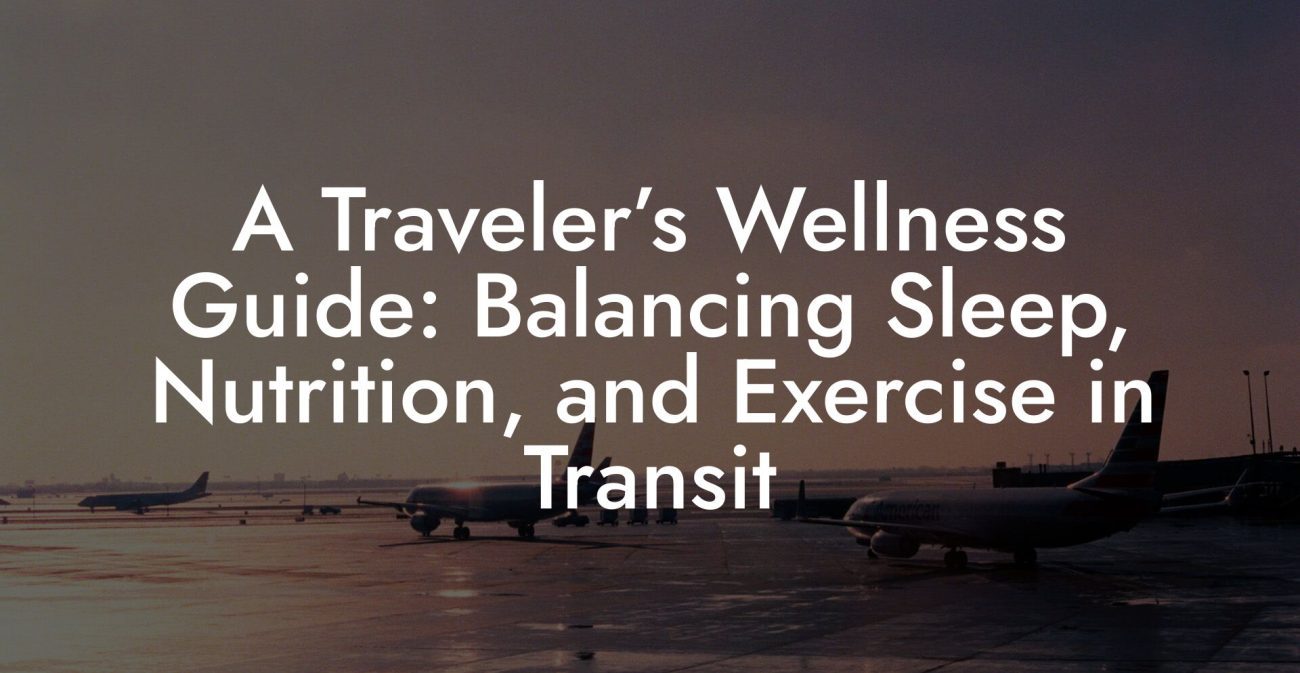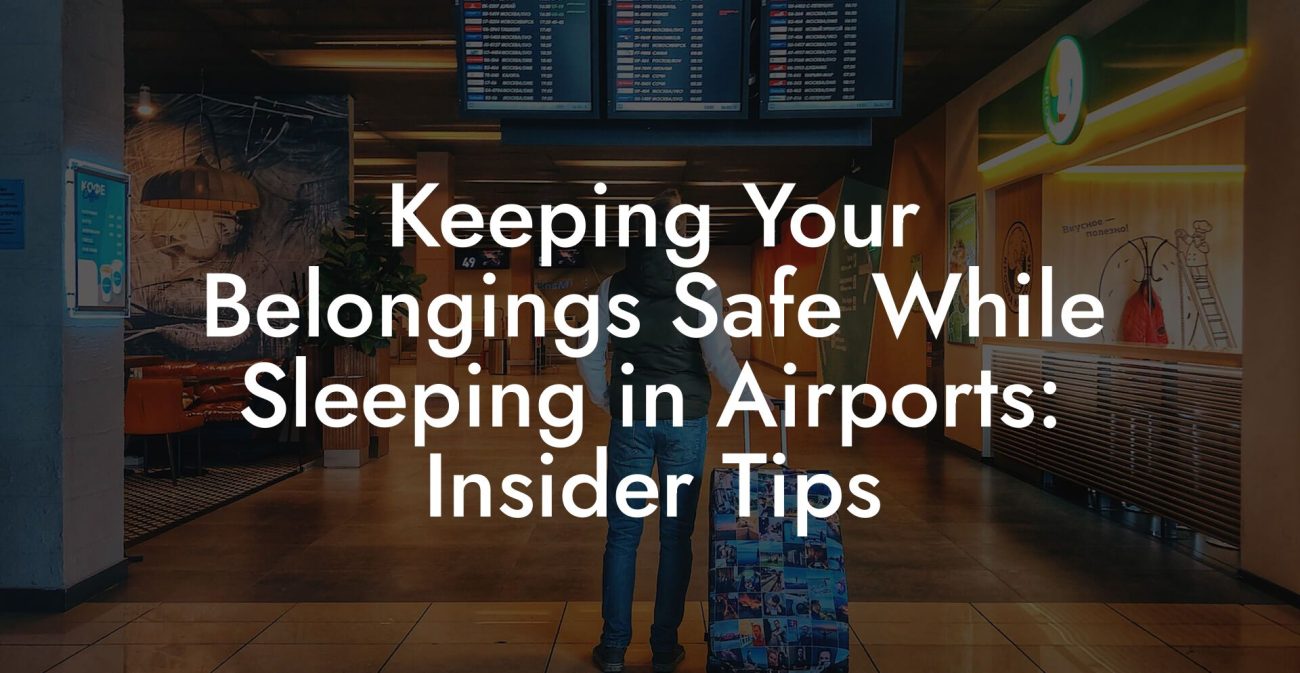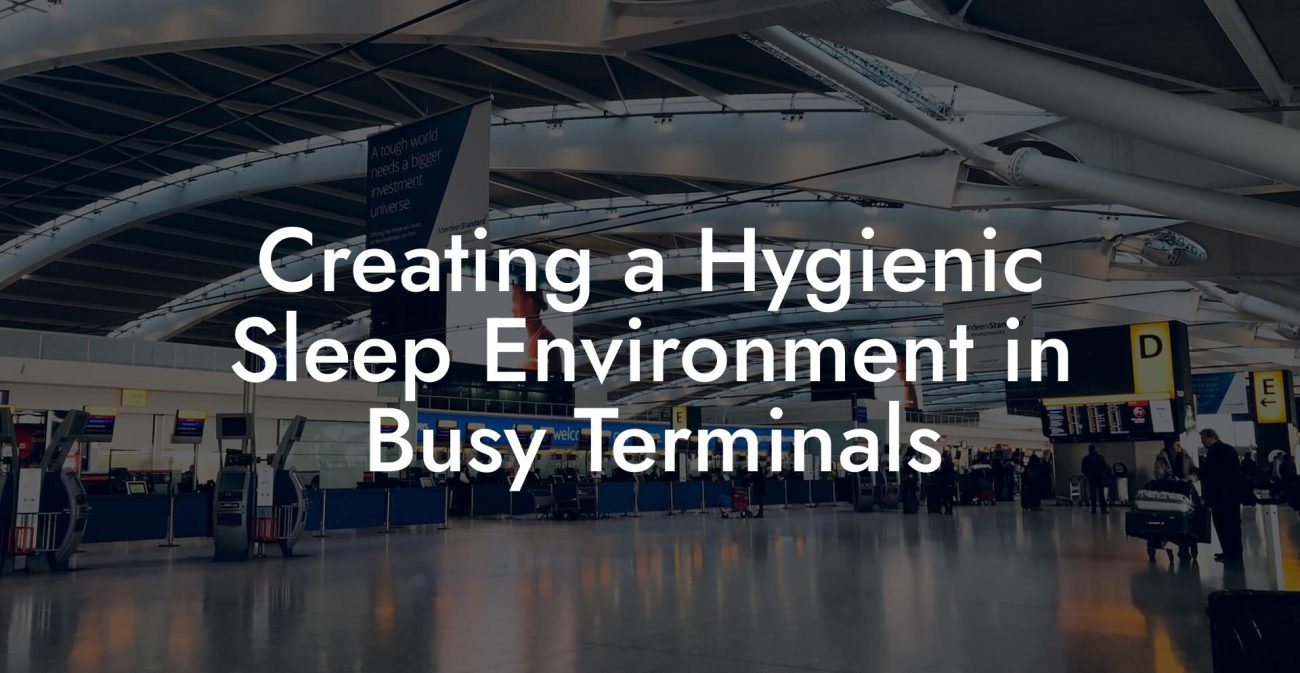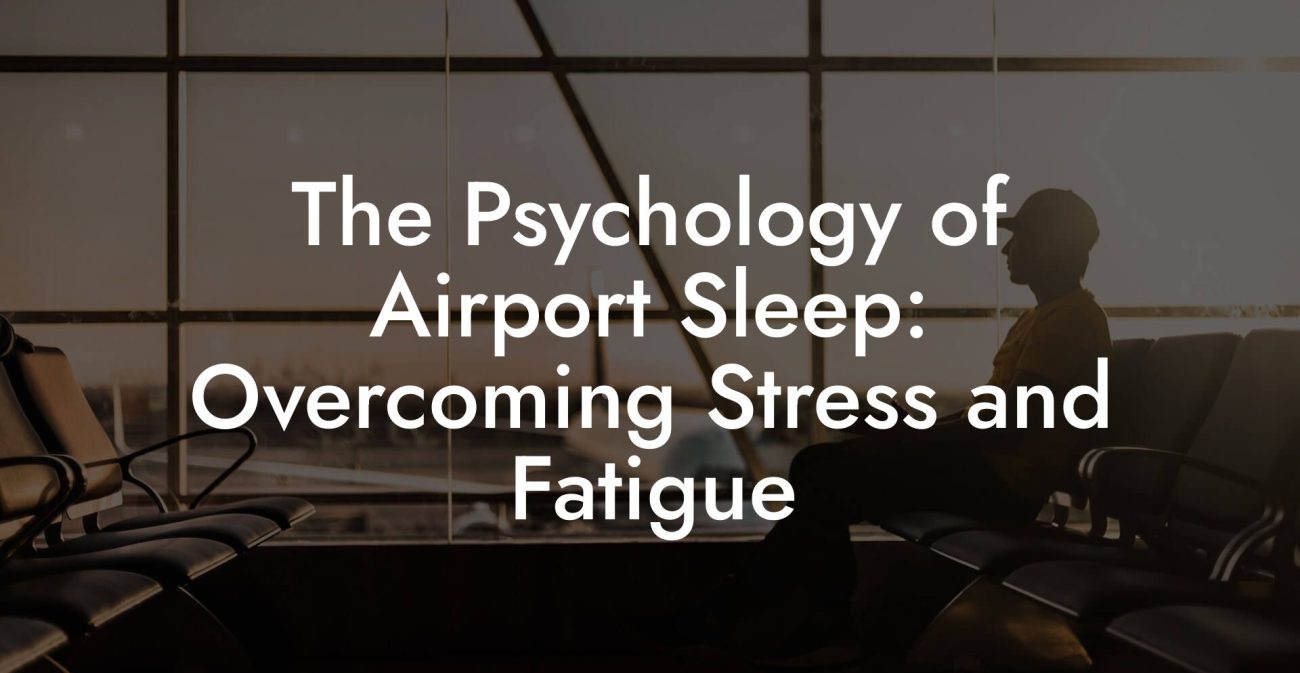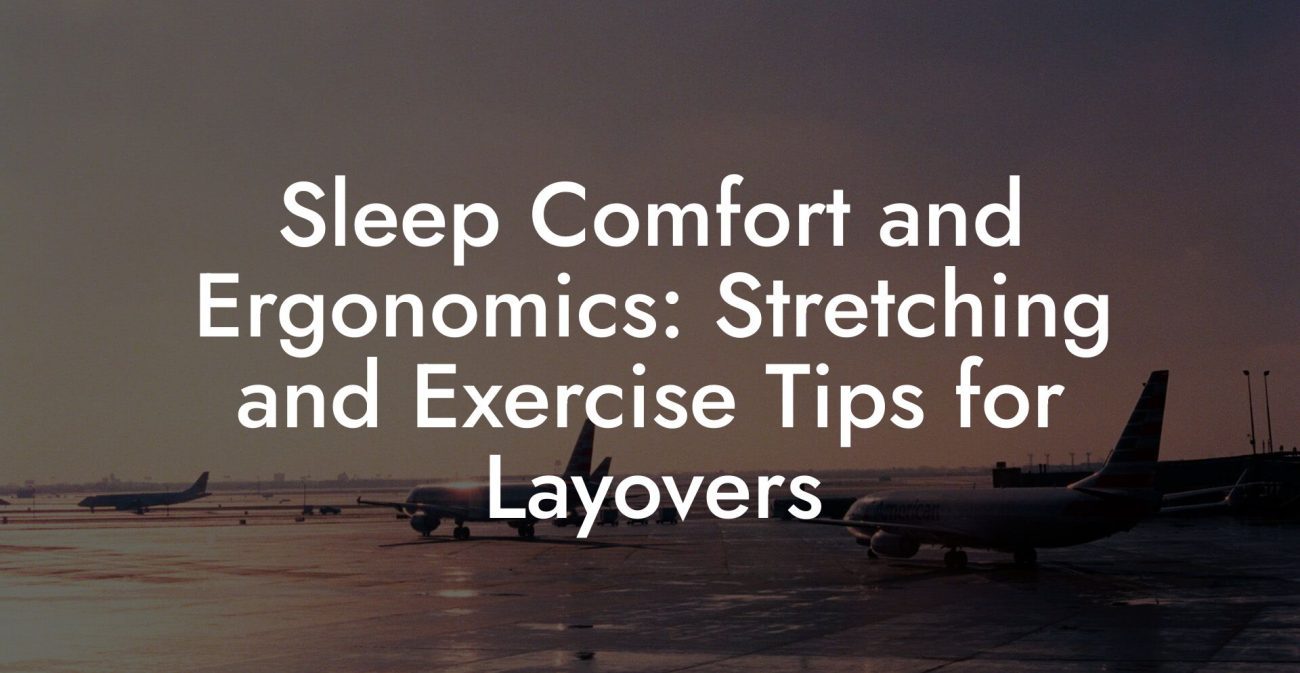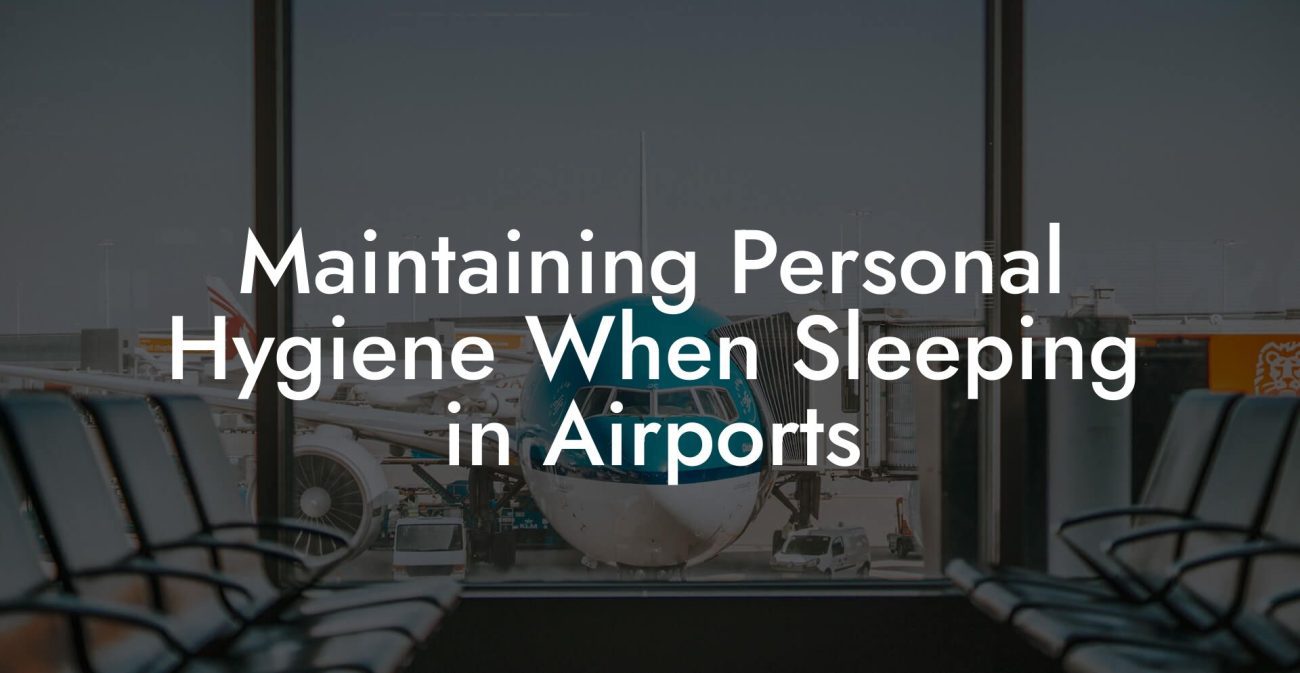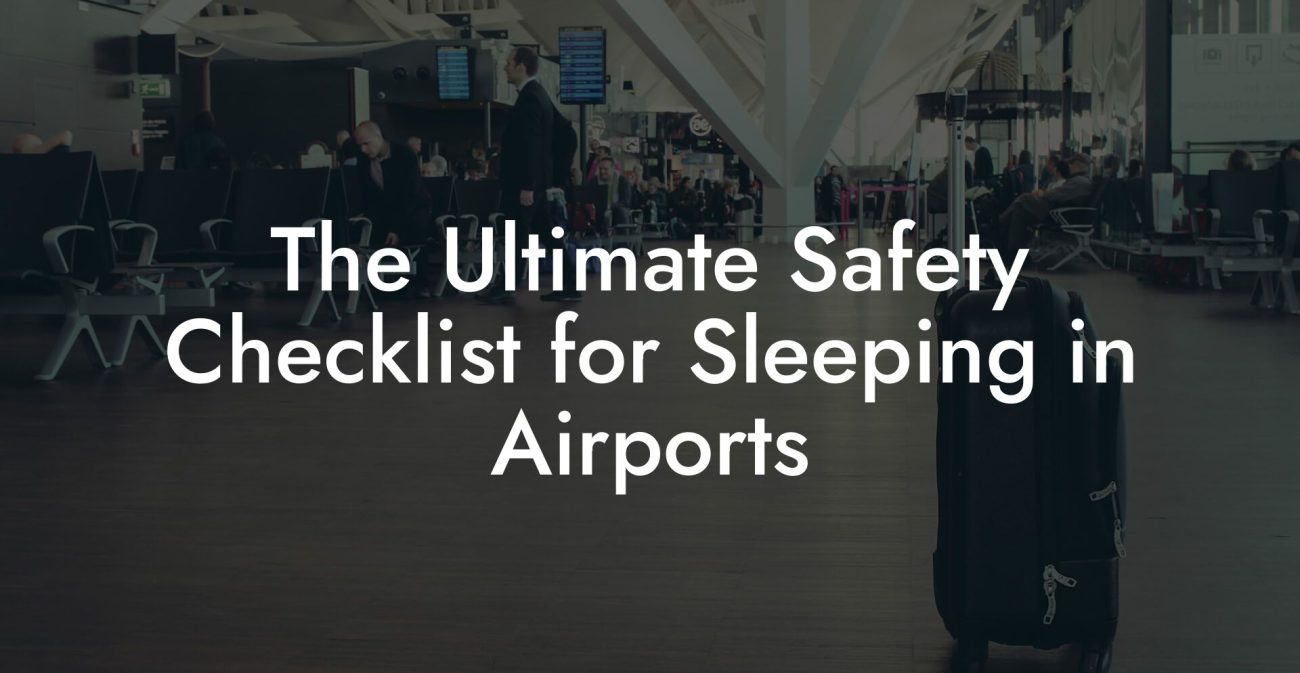Ever found yourself drifting off in an airport lounge, surrounded by the hum of travelers and flight announcements, and thought, “Hey, why not make this impromptu terminal nap a healthy escape?” Whether it’s an ultra-long layover, an overnight delay, or that dreaded red-eye flight, sleeping in airports isn’t just a last-resort solution—it’s an art form. In this comprehensive guide, we break down the top tips and tricks to keep you feeling fresher than your carry-on deodorant while nailing that airport snooze with style.
Quick Links to Useful Sections
- The Airport Slumber Saga: Why We Sleep in Terminals
- Identifying the Challenges: The Health Hurdles of Terminal Napping
- Pre-Flight Prep: Assembling Your Airport Sleep Survival Kit
- Pillows, Blankets, and Beyond
- Noise-Canceling Essentials
- Comfort Wear and Hygiene Must-Haves
- Healthy Snacks and Hydration Stations
- Mastering the Art of Airport Sleeping Pods
- Finding a Sleeping Pod: The Insider Tips
- Optimizing Pod Use for Maximum Rest
- Health Benefits of a Pod-Centric Nap
- Sleep Like a Pro: Proven Techniques for Airport Slumber
- Establish a Pre-Nap Routine
- Vertical Sleeping Strategies
- Mindfulness and Deep Breathing
- Adjusting for Time Zones
- Keeping Your Body in Motion: Healthy Habits for Layover Fitness
- Stretch It Out
- Walking Tours in the Terminal
- Meditative Movement and Light Exercise
- Nutrition and Hydration: Fueling Your Airport Sleep Strategy
- The Power of Hydration
- Smart Snacking for Sustained Energy
- Avoid the Sugary Trap
- Safety and Security: Staying Protected During Terminal Naps
- Keep Your Valuables in Check
- Choose Your Spot Wisely
- Travel Alarm Systems and Apps
- Mental Health and Mindfulness: Nurturing Your Inner Zen in Chaos
- Micro-Meditations On the Go
- Gratitude Practices and Journaling
- Tech Detox Strategies
- Resources and Community Support: Your Next Steps
- Airport Sleep Success Stories: Real Travelers, Real Wins
- The Layover Transformation
- A Night at Terminal 4
- The Jet Lag Buster
- Creating Your Personalized Healthy Airport Sleep Plan
- Step 1: Evaluate Your Travel Schedule
- Step 2: Map Out Terminal Options
- Step 3: Assemble Your Custom Survival Kit
- Step 4: Practice Your Pre-Nap Routine
- Step 5: Embrace Flexibility and Adjust as Needed
- Frequently Asked Questions About Airport Sleep and Health
- Your Roadmap to Restful, Healthy Airport Sleep
The Airport Slumber Saga: Why We Sleep in Terminals
Let’s face it: modern travel often spins us through a maze of delays and layovers that can turn even the most seasoned adventurer into a temporary couch-surfer. Airports around the world are evolving beyond mere transit hubs—they’re turning into miniature cities that bustle with 24/7 energy, sometimes forcing you to sleep between gates or even in those magical airport sleeping pods. But why do we choose to sleep in an airport?
For many Gen-Zers and millennials, it’s all about efficiency and spontaneity. A quick power nap can recharge your battery when your flight is delayed, allowing you to be alert for that unexpected networking opportunity or last-minute adventure. And for others, targeted airport sleep means catching those extra z’s without disrupting a busy travel schedule—because your time is worth more than just waiting around.
Beyond the necessity, sleeping in airports can turn into a unique experience—a chance to observe diverse travelers, discover hidden corners of a terminal, and, if you’re lucky, even score a pair of complimentary sleeping pods that rival some boutique hotel rooms!
Identifying the Challenges: The Health Hurdles of Terminal Napping
As much as airport sleeping may seem like a traveler’s rite of passage, it comes with its own set of challenges, particularly when it comes to staying healthy and well-rested. Airports are inherently bustling, with bright lights, constant noise, and unpredictable rest opportunities. The lack of privacy and comfort can lead to restless sleep, stiffness, and even a dip in your overall mood.
Some common issues include:
- Sleep Disruptions: Unpredictable ambiance, intermittent PA announcements, and the perpetual hum of a busy terminal can keep your sleep cycle off-kilter.
- Dehydration: Long waits and dry air inside terminals may leave you parched, draining your energy reserves faster than you can say “caffeine fix.”
- Physical Discomfort: Sleeping on concrete floors or uncomfortable chairs can lead to back pain and stiffness, particularly if you’re in a prolonged period of inactivity.
- Nutritional Pitfalls: Airport food might not always hit the mark in terms of health—think salty snacks and sugary drinks rather than energy-boosting fare.
- Safety & Security: While most airports are very safe, sleeping in a public area always warrants a few extra precautions to keep your belongings and personal safety intact.
Recognizing these potential hurdles is the first step in mastering the healthy airport sleep lifestyle, and we’ve got a treasure trove of strategies to help you overcome them.
Pre-Flight Prep: Assembling Your Airport Sleep Survival Kit
Just like a savvy traveler packs the perfect outfit for a destination, curating an airport sleep survival kit takes your rest game to a whole new level. Think of your kit as the Swiss Army knife for your terminal napping needs—a well-rounded collection to shield you from the chaos of the airport and enhance your relaxation.
Pillows, Blankets, and Beyond
A compact, travel-friendly pillow can make a world of difference when searching for comfort among the hard, cold seats. Inflatable neck pillows aren’t just an airline staple—they’re a must-have for any savvy airport napper. Opt for a small, plush blanket to fend off those chill drafts that creep in from open terminal doors. And if you can snag access to an airport sleeping pod, consider that your golden ticket to rest.
Noise-Canceling Essentials
With the buzz of conversations, intercom announcements, and the occasional overhead luggage cart, silence is a rare commodity in an airport. Invest in a quality pair of noise-canceling headphones or earbuds and consider downloading a sleep-inducing playlist. White noise apps or sound machines can also help drown out the chaotic background, ensuring that your airport shield of sleep is as undisturbed as possible.
Comfort Wear and Hygiene Must-Haves
Swap your business attire for something more lounge-friendly—think soft, layered clothing that transitions seamlessly from check-in to shutdown mode. A fresh set of undies, a change of clothes, and even a travel-size hygiene kit stocked with essentials like a toothbrush, face wipes, and moisturizer are small investments for maximum comfort. Staying fresh isn’t just about hygiene—it’s about feeling ready to conquer the jet lag once you hit your final destination.
Healthy Snacks and Hydration Stations
The temptation of overpriced airport junk food is real. Instead, pack a few healthy snacks like nuts, fruits, or energy bars that keep your energy levels balanced. Reusable water bottles and hydration packs are crucial—hydrate before, during, and after your flight. A well-timed sip is your secret weapon against dehydration-induced headaches and fatigue.
Your survival kit is all about blending comfort, functionality, and wellness. With the right gear at your fingertips, even the busiest terminals can transform into a temporary haven of recovery.
Mastering the Art of Airport Sleeping Pods
As airports continue to upgrade their amenities, sleeping pods have emerged as the ultimate oasis for terminal sleep. These sleek, futuristic havens offer a level of privacy and comfort that can redefine your perception of airport napping. But, like any high-tech retreat, tapping into their full potential requires a little know-how.
Finding a Sleeping Pod: The Insider Tips
Not every airport offers dedicated sleeping pods, so your first step is to scout out your terminal in advance. Use airport maps and mobile apps to locate these gems—often situated away from the main hustle or near luxury lounges. If you’re lucky enough to have a membership or credit card lounge access, check to see if sleeping pods are included.
Optimizing Pod Use for Maximum Rest
Once you secure a spot, take a proactive approach to your sleep health. Bring your own travel pillow or blanket if you have room in your bag, even if the pods come equipped with basic amenities. Use your noise-canceling earbuds and set your device on airplane mode to avoid unexpected call interruptions. Dim the pod’s lights to create a more relaxing, cave-like ambiance that naturally encourages sleep.
Health Benefits of a Pod-Centric Nap
Sleeping pods are not just about enhanced comfort—they can also contribute to your overall well-being by reducing the disruption of your circadian rhythms. With adjustable lighting and comfortable seating, they allow for a more controlled sleep environment than public seating areas. Over time, consistent use of sleeping pods can help ease travel stress and even improve post-flight recovery.
Sleep Like a Pro: Proven Techniques for Airport Slumber
While the right gear sets you up for success, honing your personal sleep techniques is the cherry on top of the airport sleeping cake. These tried-and-tested methods are designed to help you fall asleep faster, sleep deeper, and wake up feeling like you’ve just had a luxurious stay at a boutique hotel.
Establish a Pre-Nap Routine
Yes, even when you’re surrounded by terminal chaos, a mini pre-nap ritual can signal your brain that it’s time to shut down. Whether it’s a few minutes of deep breathing, a stretch, or listening to calming music, this routine helps create a mental boundary between wakefulness and sleep.
Vertical Sleeping Strategies
Not all airport seating is designed for lying down; often, you must resort to creative vertical sleeping techniques. Lean against a wall with your bag strategically placed underneath for support, or use your backpack as a makeshift pillow. With a little flexibility and a dash of creativity, even a slim window seat can turn into a restful nook.
Mindfulness and Deep Breathing
Engage in mindfulness meditation and deep breathing exercises to calm your racing thoughts and relax stiff muscles. A few focused breaths can lower your stress levels, making it easier to drift into sleep despite the surrounding hustle and bustle. This not only improves your sleep quality but also enhances your overall travel well-being.
Adjusting for Time Zones
Jet lag might loom on the horizon, but a well-planned airport nap can help realign your body clock. If you know your destination’s time zone, try to coordinate your sleep to either mimic nighttime or a nap window—this way, you hit the ground running when you land.
Keeping Your Body in Motion: Healthy Habits for Layover Fitness
Sure, a long layover might feel like the perfect time to sleep it off, but don’t let immobility rob you of a healthy travel experience! Incorporating light exercise into your airport routine not only boosts your physical well-being but also enhances your sleep quality later on.
Stretch It Out
Every traveler knows that sitting for extended periods can lead to a stiff back and sore legs. Use the layover as an opportunity to stretch—simple exercises like toe touches, arm circles, and shoulder rolls can lead to a surprisingly nimble and relaxed body. Look for designated stretching areas or even a quiet corner where you can practice a few yoga poses.
Walking Tours in the Terminal
Many modern airports are sprawling environments filled with art installations, gardens, and even light trails. Turn your wait into an adventure by taking leisurely walks along the terminal corridors. Not only does this help keep your blood circulating, but it also gives you a chance to explore unique airport amenities and perhaps discover a hidden gem—like a quiet reading nook or an outdoor terrace.
Meditative Movement and Light Exercise
If you’re up for a bit of mindful movement, try incorporating simple exercises like tai chi or gentle Pilates stretches in a secluded area. These can reduce stress, boost your energy levels, and prepare your body for a more restorative sleep later.
Remember, staying in motion isn’t just about avoiding stiffness—it’s a vital part of maintaining your overall health during travel. Even minimal physical activity can recharge your body and mind, making that power nap even more effective.
Nutrition and Hydration: Fueling Your Airport Sleep Strategy
What’s the point of catching some quality shut-eye if your body isn’t given the right fuel to recover? Healthy nutrition and hydration are cornerstones of any effective airport sleep strategy. When your flight schedule gets all over the place, maintain your energy by choosing nourishing options over tempting junk food.
The Power of Hydration
Air travel is synonymous with dry, recirculated air. Even if you’re snoozing in a quiet corner, dehydration can sabotage your recovery. Always have a refillable water bottle handy, and aim to sip water before, during, and after your flight. Pro tip: infuse your water with a slice of lemon or cucumber for a refreshing twist.
Smart Snacking for Sustained Energy
Skip the vending machine’s lure of overly salted chips and opt for healthier alternatives. Nut mixes, granola bars, fresh fruits, and yogurt cups provide sustained energy without the crash. Packing your own healthy snacks shows that you’re not only a master of airport napping but also a champion of self-care.
Avoid the Sugary Trap
While it might be tempting to grab an energy drink or a soda for that quick buzz, these sugary treats often lead to an energy dip right when you need to be alert post-flight. Focus on balanced nutrition that includes protein, fiber, and healthy fats—and let your body recover naturally without the rollercoaster of sugar highs.
Safety and Security: Staying Protected During Terminal Naps
Sleeping in a public space inevitably raises questions about safety. But with a few smart precautions, you can keep your belongings secure and your mind at ease while you catch some Z’s.
Keep Your Valuables in Check
Always stow your valuables in a secure, hard-to-reach compartment in your bag or consider a travel safe with a lock. Wearing a money belt or a crossbody bag with anti-theft features can also give you peace of mind when you’re drifting off in a busy terminal.
Choose Your Spot Wisely
Look for areas that have a natural flow of people without being overly crowded. Many airports have designated rest zones with better lighting and occasional security patrols. These areas not only offer a quieter sleeping environment but also add an extra layer of safety.
Travel Alarm Systems and Apps
In case you do fall into a deep sleep, set a travel alarm or use an app that gently wakes you up before your boarding time. These tools can help you balance uninterrupted sleep with the need to stay on schedule.
Mental Health and Mindfulness: Nurturing Your Inner Zen in Chaos
Airports are a living paradox—a mix of relentless motion and sudden stillness. Amid the clamor and the constant rush, cultivating your mental well-being becomes crucial. Integrating mindfulness and stress-relief practices into your airport routine can transform your experience from stressful to surprisingly serene.
Micro-Meditations On the Go
Even if you have only a few minutes between flights, a short meditation session can recalibrate your mindset. Find a quiet corner, close your eyes, and focus on your breathing. This mini recharge helps clear your mind and resets your internal clock.
Gratitude Practices and Journaling
While it might seem quirky, taking a few moments to jot down something you’re grateful for can shift your perspective and reduce stress. A gratitude journal or a simple note on your phone can remind you that every travel hiccup is an opportunity for growth—and even adventure.
Tech Detox Strategies
Our phones are lifelines in transit, but constantly checking notifications can spike stress. Dedicate part of your airport rest time to a mini digital detox. Let your brain decompress and transition from the high-energy environment to the calm of a restful pause.
Resources and Community Support: Your Next Steps
Navigating the world of airport sleeping may seem daunting, but remember—you’re not alone. There’s a vibrant community of travelers who have perfected the art of terminal napping and are eager to share their wisdom. Online forums, travel blogs, and social media groups are bursting with tips, insider knowledge, and even real-time updates on the best spots to catch some shut-eye at airports.
Check out reputable travel websites and YouTube channels dedicated to airport hacks. Apps like Sleep Cycle and LoungeBuddy can help you map out your ideal napping conditions and connect you with like-minded travel enthusiasts. From portable travel gear recommendations to reviews of airport sleeping pods in major hubs, these resources equip you with the tools to conquer any layover like a pro.
Engaging with your travel community is a powerful step toward embracing a healthier, more pleasurable travel lifestyle. Whether it’s swapping stories on Reddit or joining Facebook groups focused on travel wellness, these networks are here to support your journey—reminding you that every great adventure sometimes starts with a well-timed airport nap.
Airport Sleep Success Stories: Real Travelers, Real Wins
The terminal isn’t just a place to wait—it’s a backdrop for unexpected breakthroughs and personal triumphs. Many travelers have turned their impulsive naps into a healthy lifestyle hack, leading to improved sleep, reduced travel stress, and even better performance on the go.
The Layover Transformation
Meet Alex, a digital nomad who once dreaded layovers for their exhausting delays. After embracing airport sleeping pods, noise-canceling headphones, and a robust pre-nap routine, Alex revealed that his energy levels soared on long trips and his productivity skyrocketed upon landing. His willingness to experiment with travel-focused wellness turned a dreaded downtime into a recharging ritual.
A Night at Terminal 4
Then there’s Jamie—a millennial who thought that sleeping in terminals was an awkward, uncomfortable ordeal. Through trial, error, and a hefty dose of humor, Jamie discovered that a few strategic tweaks (like a portable pillow, an anti-blue light screen filter, and practicing mindfulness) could transform a noisy terminal corner into a surprisingly serene retreat. Now, Jamie swears by her travel sleep toolkit, sharing her tips on travel blogs and inspiring others to embrace healthy airport naps.
The Jet Lag Buster
And let’s not forget Sam, whose perpetual jet lag became a thing of the past thanks to careful planning of airport napping sessions. By aligning his airport sleep with his destination’s time zone and coupling it with light exercises and mindful breathing, Sam managed to drastically cut down on travel fatigue. His innovative approach even caught the attention of fellow globetrotters, turning his airport sleep hacks into a viral phenomenon on social media.
These success stories aren’t just anecdotes—they’re proof that with a little creativity and care, you, too, can master the art of healthy airport slumber and make your travels as rejuvenating as they are adventurous.
Creating Your Personalized Healthy Airport Sleep Plan
The secret to thriving while sleeping in airports is to design a routine that suits your unique travel style, health needs, and personality. Here’s a step-by-step guide to curating your own personalized airport sleep plan:
Step 1: Evaluate Your Travel Schedule
Start by analyzing your typical travel patterns. Identify the flights, layovers, or unforeseen delays where a power nap could meaningfully boost your energy. This evaluation sets the stage for tailoring your sleep strategy around real-life travel scenarios.
Step 2: Map Out Terminal Options
Research the airports you frequent to find out which ones offer sleeping pods, quiet zones, or comfortable lounges. Bookmark these spots on your travel app, and make a note of the best times and areas for a restful nap.
Step 3: Assemble Your Custom Survival Kit
Based on your travel needs, build your portable sleep kit. Include a travel pillow, noise-canceling headphones, a compact blanket, healthy snacks, an eye mask, and a refillable water bottle. Tailor this kit so that it fits seamlessly into your carry-on bag.
Step 4: Practice Your Pre-Nap Routine
Experiment with different relaxation techniques and find out what works best for you. Develop a routine that might include stretching, meditation, or even a few pages from your favorite novel. Consistency is key.
Step 5: Embrace Flexibility and Adjust as Needed
No two travel days are alike. Keep a travel journal to note what strategies work and which need tweaking. Stay connected with fellow travelers and keep up-to-date with new airport amenities or wellness tips. This dynamic approach ensures your plan evolves along with your travel lifestyle.
By integrating these steps into your routine, you empower yourself to transform every layover and unexpected delay into a mini wellness retreat—ensuring that even when you’re on the move, your body and mind are well taken care of.
Frequently Asked Questions About Airport Sleep and Health
Below are some of the most common questions travelers ask about staying healthy while sleeping in airports and making the most of available sleeping pods:
1. Is it safe to sleep in an airport?
Yes, airports are generally safe places to sleep, especially when you choose well-monitored areas or designated rest zones. However, it’s always wise to secure your belongings and stay aware of your surroundings.
2. What are airport sleeping pods and how do they work?
Airport sleeping pods are compact, private chambers designed for quick naps. Typically equipped with comfortable seating, adjustable lighting, and sometimes even charging ports, these pods offer a unique way to rest in a controlled environment.
3. How can I ensure a restful sleep in a noisy, busy terminal?
Equip yourself with noise-canceling headphones, use a white noise app, and create a pre-nap routine that signals your brain it’s time to sleep. Choosing less congested areas or dedicated rest zones also contributes to a quieter, more relaxing environment.
4. What healthy snacks should I pack for long layovers?
Opt for nutrient-dense snacks like mixed nuts, fruits, veggie sticks, and whole-grain energy bars to maintain steady energy levels. Avoid foods high in sugar or salt, which might lead to energy crashes.
5. How do I handle jet lag when sleeping in airports?
Try to align your airport naps with the destination time zone, practice mindfulness before sleep, and incorporate light stretching during your layover. These strategies help reset your circadian rhythm for smoother transitions.
6. Can regular airport sleep truly improve my overall travel health?
Absolutely! When done with the right precautions and healthy habits, airport sleep can reduce stress, ease fatigue, and boost your productivity, making travel a more pleasurable experience.
7. What precautions should I take to secure my belongings during a nap?
Keep valuables in a secure bag, consider wearing a money belt, and choose areas with a good flow of people and security patrols—these steps will help ensure your belongings remain safe.
Your Roadmap to Restful, Healthy Airport Sleep
The journey to healthy sleep in the midst of airport chaos is one of experimentation, self-care, and a touch of travel ingenuity. By equipping yourself with the essential gear, adopting mindful pre-nap rituals, and utilizing technology and community resources for extra support, you transform every layover into a refreshing pit stop.
While airport sleeping might seem like an everyday necessity for many travelers, it’s also an opportunity—a chance to reset, recharge, and reconnect with your inner calm. Embrace the unique challenges of terminal napping as stepping stones toward a healthier, more energetic travel lifestyle.
As you implement these top tips—from securing your own portable sleep kit to exploring innovative airport sleeping pods and integrating light exercise and mindfulness—you’re not just surviving your travels. You’re thriving. Every moment of rest, every mindful breath, and every burst of healthy energy is a step toward a more dynamic, healthier, and happier journey.
So, next time you find yourself amidst the hustle and bustle of an airport, remember: with a little planning and a lot of self-care, you can turn a forced layover into a rejuvenating escape—making your travels as fulfilling as your destination.
Useful Interruption: Dive deeper into the world of airport sleeping guides with our most popular sections. If there is anything you think is missing or anything you would love for us to write about, just give us a shout.
- General Airport Sleeping Guides
- Travel Gear & Equipment Recommendations
- Regional and Airport-Specific Guides
- Airport Sleeping Pods & Reviews
- Health, Safety, and Comfort Tips for Airport Sleepers
Last week, I decided to try the world-famous "airport sleepover" experience. Imagine this: I'm lying on a bench in Terminal C, surrounded by suitcases that have seen more of the world than I ever will, and a PA system that sounds like a karaoke machine on a sugar rush. I pull out my travel pillow—which, by the way, is more like a sad deflated balloon—and declare, "Tonight, I’m the king of this terminal!"
Soon enough, fellow travelers become my unexpected audience. One guy, fresh off a red-eye, whispers, "Hey, do you think if we sleep long enough, we can catch our flight in our dreams?" I reply, "Sure, and maybe I'll even get an upgrade to first-class in my nap!" The airport lights flicker like a disco ball, and every time someone announces a delayed departure, it’s like a punchline to our impromptu stand-up routine.
As I finally drift off, I dream of a world where boarding passes are like VIP tickets to the best sleepover party ever—a party where the only baggage is the laughter you carry with you. Waking up, I realize the airport is still the same, but I now hold the honorary title of "Terminal Comedian," a title I wear with as much pride as my permanently mismatched socks!


